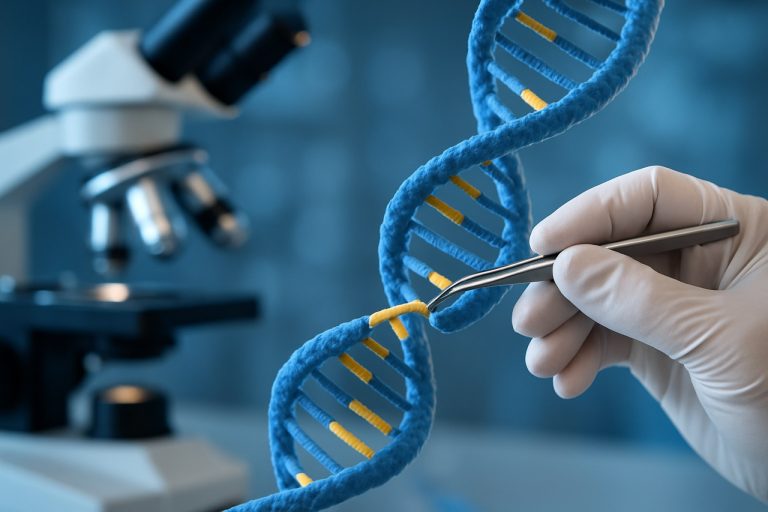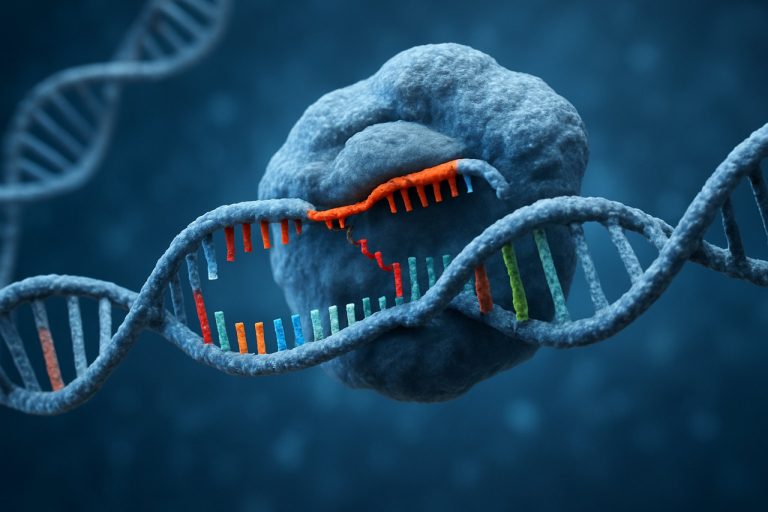
Unlocking the Future of Genetic Engineering: How CRISPR Prime Editing is Redefining Precision, Safety, and Possibility in DNA Modification
- Introduction to CRISPR Prime Editing
- How Prime Editing Differs from Traditional CRISPR-Cas9
- Mechanism: The Science Behind Prime Editing
- Advantages and Limitations of Prime Editing
- Current Applications in Medicine and Biotechnology
- Recent Breakthroughs and Case Studies
- Ethical Considerations and Regulatory Landscape
- Challenges and Future Directions for Prime Editing
- Sources & References
Introduction to CRISPR Prime Editing
CRISPR Prime Editing is an advanced genome engineering technology that enables precise and versatile genetic modifications without introducing double-strand breaks in DNA. Developed as an evolution of the original CRISPR-Cas9 system, prime editing utilizes a catalytically impaired Cas9 fused to a reverse transcriptase enzyme, guided by a specially designed prime editing guide RNA (pegRNA). This system allows for targeted insertions, deletions, and all 12 possible base-to-base conversions, offering a significant improvement in specificity and versatility over earlier genome editing tools Nature.
The introduction of CRISPR Prime Editing has addressed several limitations associated with traditional CRISPR-Cas9 and base editing technologies, such as unwanted insertions or deletions (indels) and off-target effects. By avoiding double-strand breaks, prime editing reduces the risk of genomic instability and enhances the fidelity of genetic modifications. This makes it particularly attractive for therapeutic applications, where precision and safety are paramount Broad Institute.
Since its initial demonstration in 2019, CRISPR Prime Editing has rapidly gained attention in the scientific community for its potential to correct pathogenic mutations underlying genetic diseases, engineer model organisms, and advance synthetic biology. Ongoing research is focused on improving the efficiency, delivery, and specificity of prime editors, as well as expanding their applicability to a wider range of cell types and organisms National Human Genome Research Institute.
How Prime Editing Differs from Traditional CRISPR-Cas9
Prime editing represents a significant advancement over traditional CRISPR-Cas9 genome editing by offering greater precision and versatility in genetic modifications. While the classic CRISPR-Cas9 system relies on creating double-stranded breaks (DSBs) at specific genomic locations, which are then repaired by the cell’s error-prone mechanisms, prime editing employs a more refined approach. It uses a fusion protein composed of a catalytically impaired Cas9 (nickase) and a reverse transcriptase enzyme, guided by a prime editing guide RNA (pegRNA). This system enables the direct writing of new genetic information into a target site without requiring DSBs or donor DNA templates, thereby reducing the risk of unintended insertions, deletions, or chromosomal rearrangements commonly associated with traditional CRISPR-Cas9 editing Nature.
Another key distinction is the range of possible edits. Traditional CRISPR-Cas9 is primarily suited for gene knockouts or small insertions and deletions, whereas prime editing can introduce all twelve possible base-to-base conversions, as well as small insertions and deletions, with high specificity. This expanded editing capability makes prime editing particularly valuable for correcting pathogenic point mutations and modeling genetic diseases Broad Institute.
Furthermore, prime editing’s reduced reliance on the cell’s endogenous repair pathways leads to fewer off-target effects and lower cytotoxicity. This makes it a promising tool for therapeutic applications where precision and safety are paramount National Human Genome Research Institute.
Mechanism: The Science Behind Prime Editing
CRISPR Prime Editing represents a significant advancement in genome engineering, offering a versatile and precise method for introducing targeted genetic changes without requiring double-strand DNA breaks or donor DNA templates. The core mechanism relies on a fusion protein composed of a catalytically impaired Cas9 nickase (nCas9) and a reverse transcriptase (RT). This fusion is guided to the target DNA sequence by a specially designed prime editing guide RNA (pegRNA), which not only directs the complex to the specific genomic locus but also encodes the desired edit within an extended sequence at its 3’ end.
Upon binding to the target site, the nCas9 component introduces a single-strand nick in the DNA, rather than a double-strand break as in traditional CRISPR-Cas9 editing. The RT domain then uses the pegRNA as a template to synthesize the edited DNA sequence directly onto the target strand. Cellular repair mechanisms subsequently incorporate the newly synthesized DNA, resulting in precise base substitutions, insertions, or deletions as specified by the pegRNA. This process minimizes the risk of unwanted insertions or deletions (indels) and off-target effects, which are common challenges in earlier genome editing technologies.
The flexibility of prime editing allows for a wide range of genetic modifications, including all possible base-to-base conversions and small insertions or deletions, making it a powerful tool for both research and potential therapeutic applications. For a detailed explanation of the prime editing mechanism, see Nature and Broad Institute.
Advantages and Limitations of Prime Editing
CRISPR Prime Editing represents a significant advancement in genome engineering, offering several advantages over traditional CRISPR-Cas9 and base editing technologies. One of its primary strengths is its versatility: prime editing can introduce all types of point mutations, small insertions, and deletions without requiring double-strand breaks or donor DNA templates, thereby reducing the risk of unwanted insertions or chromosomal rearrangements. This precision minimizes off-target effects and enhances the safety profile of genome editing, which is particularly important for therapeutic applications. Additionally, prime editing has demonstrated high efficiency in a variety of cell types and organisms, broadening its potential utility in both research and clinical settings Nature.
However, prime editing is not without limitations. Its efficiency can vary depending on the target sequence, cell type, and the nature of the intended edit. The system relies on the delivery of relatively large protein-RNA complexes, which can pose challenges for in vivo applications, especially in tissues that are difficult to transfect or in organisms with limited delivery options. Furthermore, while off-target effects are reduced compared to standard CRISPR-Cas9, they are not entirely eliminated, and unintended edits can still occur, particularly at sites with partial sequence homology Cell. Finally, the technology is still evolving, and further optimization is needed to improve editing efficiency, expand the range of editable sequences, and ensure robust and safe delivery methods for therapeutic use National Human Genome Research Institute.
Current Applications in Medicine and Biotechnology
CRISPR prime editing has rapidly emerged as a transformative tool in medicine and biotechnology, offering unprecedented precision for genome modification. Unlike traditional CRISPR-Cas9 systems, which rely on double-strand breaks and the cell’s error-prone repair mechanisms, prime editing uses a catalytically impaired Cas9 fused to a reverse transcriptase, guided by a prime editing guide RNA (pegRNA) to introduce targeted insertions, deletions, and all 12 possible base-to-base conversions without requiring donor DNA templates or generating double-strand breaks. This versatility has enabled a range of innovative applications.
In medicine, prime editing is being explored for the correction of pathogenic mutations underlying genetic diseases. Proof-of-concept studies have demonstrated successful correction of mutations responsible for conditions such as sickle cell disease, Tay-Sachs disease, and cystic fibrosis in human cells, highlighting its therapeutic potential Nature. Additionally, prime editing is being investigated for ex vivo editing of patient-derived cells, which can then be reintroduced to treat hematological and metabolic disorders Cell.
In biotechnology, prime editing is facilitating the development of improved crop varieties by enabling precise trait modifications, such as enhanced disease resistance and stress tolerance, without introducing foreign DNA Science. Furthermore, it is being used to engineer cell lines for research and biomanufacturing, allowing for the creation of models with specific genetic alterations and the optimization of protein production systems. As the technology matures, its applications are expected to expand, driving advances in both therapeutic and industrial biotechnology.
Recent Breakthroughs and Case Studies
Recent years have witnessed significant breakthroughs in CRISPR prime editing, expanding its potential for precise genome modification. One notable advancement is the development of enhanced prime editors, such as PE3 and PE5, which improve editing efficiency and reduce unwanted byproducts. For example, researchers at the Broad Institute demonstrated that PE3, which introduces a nick in the non-edited DNA strand, can substantially increase editing rates in both human and plant cells. Further optimization, as seen in PE5, incorporates engineered proteins to boost editing precision and minimize off-target effects.
Case studies highlight the therapeutic promise of prime editing. In 2022, a team at Harvard University successfully corrected the mutation responsible for sickle cell disease in human hematopoietic stem cells, restoring normal hemoglobin production. Similarly, researchers at Stanford University applied prime editing to correct genetic mutations in mouse models of Duchenne muscular dystrophy, leading to improved muscle function and reduced disease symptoms.
Prime editing has also been applied in agriculture. Scientists at the Cornell University used the technology to introduce disease-resistant traits in rice and wheat, demonstrating its utility for crop improvement without introducing foreign DNA. These breakthroughs underscore the versatility and transformative potential of CRISPR prime editing across medicine and biotechnology, while ongoing studies continue to refine its accuracy and broaden its applications.
Ethical Considerations and Regulatory Landscape
CRISPR prime editing, as a next-generation genome editing technology, raises significant ethical considerations and regulatory challenges due to its unprecedented precision and versatility. Unlike earlier CRISPR systems, prime editing can introduce targeted insertions, deletions, and all 12 possible base-to-base conversions without requiring double-strand breaks, potentially reducing off-target effects and unintended consequences. However, this increased capability also amplifies concerns about misuse, especially in germline editing, which could result in heritable genetic changes. Ethical debates focus on the potential for “designer babies,” inequitable access, and unforeseen long-term effects on human health and biodiversity.
Regulatory frameworks for CRISPR prime editing are still evolving. In the United States, oversight is shared among agencies such as the U.S. Food and Drug Administration and the National Institutes of Health, which evaluate clinical applications and research funding, respectively. The European Medicines Agency and national authorities in the European Union have issued guidance on gene editing in therapeutics, emphasizing risk assessment and public engagement. Internationally, organizations like the World Health Organization have called for global standards and a registry of human genome editing research to promote transparency and ethical oversight.
Despite these efforts, regulatory harmonization remains a challenge, with significant variation in national policies regarding clinical trials, germline editing, and agricultural applications. Ongoing dialogue among scientists, ethicists, policymakers, and the public is essential to ensure that CRISPR prime editing is developed and deployed responsibly, balancing innovation with societal values and safety concerns.
Challenges and Future Directions for Prime Editing
Despite its transformative potential, CRISPR prime editing faces several technical and practical challenges that must be addressed before widespread clinical and research adoption. One major hurdle is the relatively low editing efficiency in certain cell types and organisms, which can limit its utility for therapeutic applications. Optimization of prime editor protein variants, pegRNA design, and delivery methods are active areas of research aimed at improving efficiency and specificity Nature Biotechnology.
Another significant challenge is the risk of unintended edits, including off-target effects and bystander mutations near the target site. Although prime editing is generally more precise than traditional CRISPR-Cas9, comprehensive genome-wide studies are needed to fully characterize and minimize these risks Cell. Additionally, the relatively large size of the prime editor construct complicates its delivery, especially in vivo, where viral vectors such as AAV have limited cargo capacity. Non-viral delivery systems and split-intein strategies are being explored to overcome these limitations Nature Biotechnology.
Looking forward, future directions for prime editing include expanding the range of editable mutations, improving delivery systems, and developing robust methods for in vivo applications. Integration with other genome engineering tools and the development of high-throughput screening platforms will further enhance its versatility. Ultimately, rigorous preclinical studies and careful ethical considerations will be essential as prime editing moves closer to clinical translation Nature Reviews Genetics.
Sources & References
- Nature
- Broad Institute
- Harvard University
- Stanford University
- Cornell University
- National Institutes of Health
- European Medicines Agency
- World Health Organization



